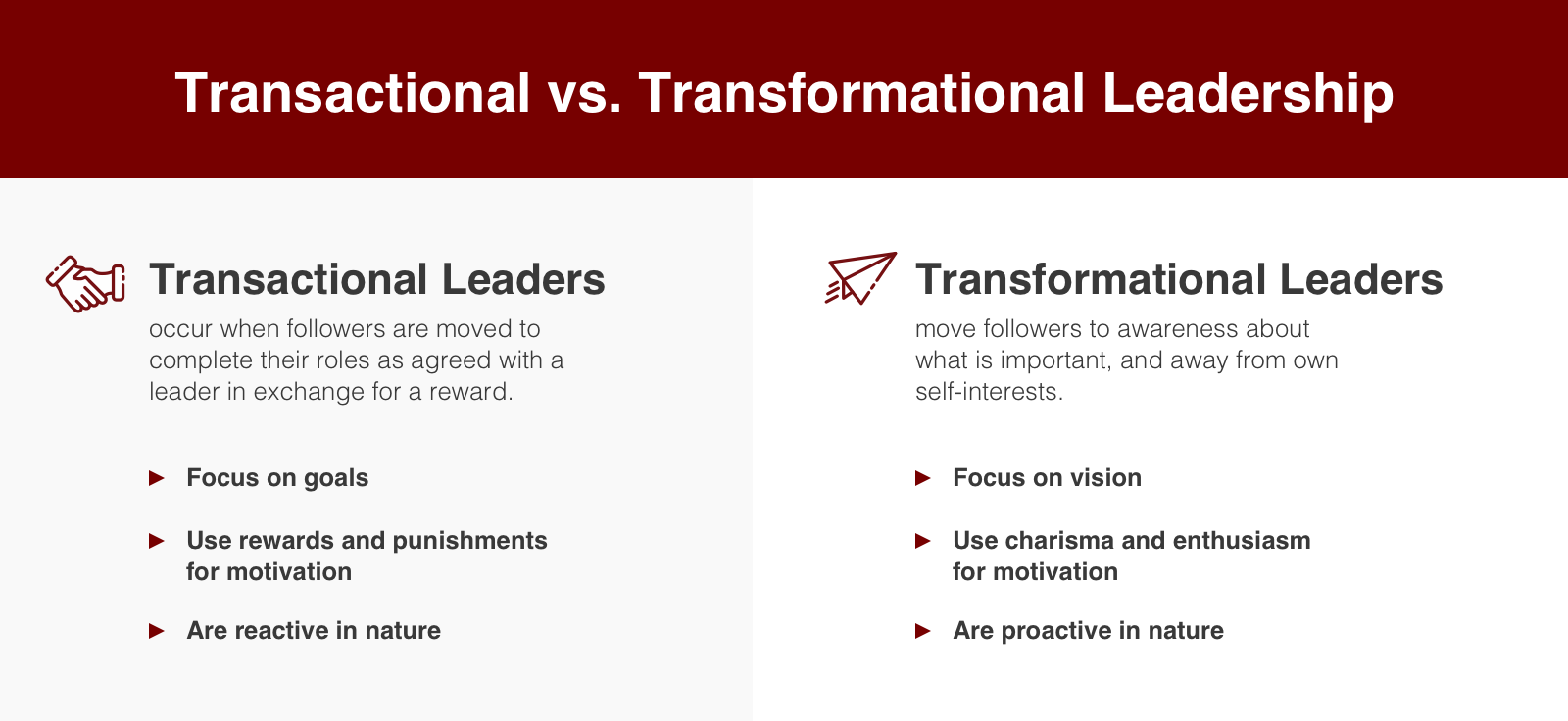There are many ways to lead a company, but most leadership styles tend to be either transactional or transformative. Here, we explore the difference between transactional and transformational leadership as well as the characteristics of each style.
Transformational vs. Transactional Leadership
Transactional leadership is primarily based on processes and control, and requires a strict management structure. Transformational leadership, on the other hand, focuses on inspiring others to follow, and it requires a high degree of coordination, communication and cooperation.
The difference can be summed up as follows: transactional leadership looks at how to get things done, and transformation leadership looks at how to motivate people to do things.
If you’re a leader in your field of work, you may wonder what these leadership styles look like in practice. Essentially, they are a continuum rather than opposites.

What is Transactional Leadership?
Characteristics of a Transactional Leader
According to a 2015 article about organizational leaders published in the International Journal of Science and Research, transactional leaders share the following characteristics:
- Replace the wants of a leader for the wants of a follower
- Emphasize development in setting goals, directing them and striving to control outcomes
- Can make important decisions
- Have a strong personality
The benefits and rewards issue of contingency comes up frequently in discussions about transactional leadership. Contingency means that workers know their reward is contingent upon them completing the tasks that have been assigned to them. So, the leader must set explicit expectations that are understood by the worker. If this transactional process is not clear, a leader might appear to be practicing coercion by not sharing common goals and tasks with an employee.
Transactional leaders usually use manage by exception, which means they won’t make changes or get involved if everything runs as expected. Negative exceptions, such as missing sales goals or production quality targets, get immediate attention. This leadership style can be noticed in various degrees of the practice and vary by goals and vision.
Examples of Transactional Leadership
Transactional leadership works best in situations when rules must be followed and hierarchy is critical, and there’s not much emphasis on innovation. Types of organizations that employ transactional leadership are the military, big corporations and NFL coaching.
Transactional leaders can succeed in crisis or on projects that require specific processes. In fact, there’s a chance that you have encountered transactional leadership throughout your life without recognizing it. Teachers that offer good grades in exchange for high academic performance is an overlooked example, as well as a job promotion offer in exchange for excellent performance.
Educational and corporate environments can also be transactional in nature. University leaders use procedural systems to be able to grade students and motivate them to perform better for academic success. Corporations use a well-defined model to compensate for employee performance.
What is Transformational Leadership?
Characteristics of a Transformational Leader
Psychologist Ronald E. Riggio identifies four elements of transformational leaders:
- Idealized influence: Leaders hold, share and demonstrate core values and trust.
- Inspirational motivation: Leaders motivate workers by conveying confidence and a sense of purpose.
- Individualized consideration: Leaders are concerned with people’s feelings and needs.
- Intellectual stimulation: Leaders provide opportunities for creativity and innovation and allow people to learn, grow and try new things.
These components, called the Four I’s, have a substantial impact on a leader’s ability to enrich both the organization and the individual. Riggio writes “… transformational leaders hold positive expectations for followers, believing that they can do their best. As a result, they inspire, empower and stimulate followers to exceed normal levels of performance.”
Examples of Transformational Leaders
According to Leadership: Theory, Application & Skill Development by Lussier & Achua, Martin Luther King, Jr. exemplifies a transformational leader because he built follower confidence, challenged taken-for-granted assumptions, developed follower needs and upheld high moral values.
Oprah Winfrey is also classified as a transformational leader by the authors due to her vision and ability to transform any venture she embarks upon.
Transformational leadership may sound admirable, but it has some disadvantages. It can be ineffectual at some stages of business growth and may not take root in a bureaucratic environment. If there is no management structure already in place, transformational leadership is not equipped to create one.
Are Transactional and Transformational Leadership Mutually Exclusive?
It’s tempting to debate which style of leadership is better, but that misses the point. Both styles are valid, and what matters is context. Some organizations need rigidity and a clear chain of command. Others work best in a fluid environment where leadership sets an example and establishes goals. Leadership styles that work for Google won’t work for the military — and vice versa.
In fact, both types of leadership styles might be needed in the same organization to counterbalance each other and help achieve growth and development goals. Transactional leaders make sure the team is running smoothly and producing results today, while transformational leaders spur innovation and look toward tomorrow. In either case education and training can be an effective tool in advancing one’s abilities as a leader.
Related Reading: